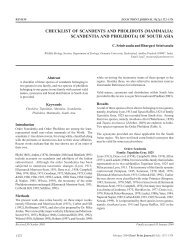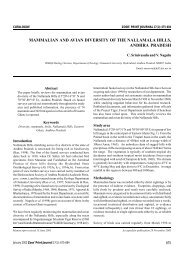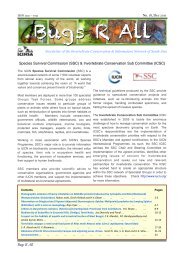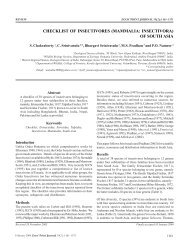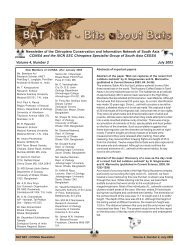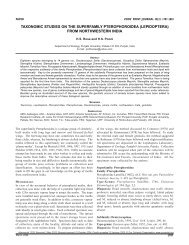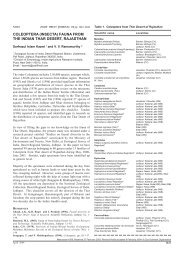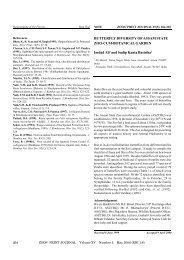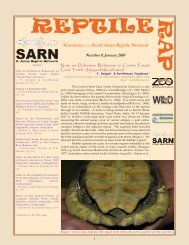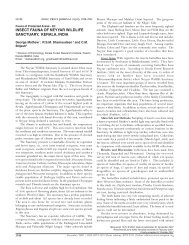Zoos - zoo's print
Zoos - zoo's print
Zoos - zoo's print
Create successful ePaper yourself
Turn your PDF publications into a flip-book with our unique Google optimized e-Paper software.
Environmental Education (Public awareness) and impact of someTraditional Knowledge Systems on EnvironmentSaurabh Vashisth * and Natasha Sethi **AbstractTraditional Knowledge systems are prevalent in our countryeven today in many aspects. Following old traditions is goodin some aspects and bad in some. Many people still followthe obsolete superstitions and cause irrevocable damage tothe environment. Those people must be educated in such away that they realize that the acts performed are damagingthe environment. This paper discusses differentsuperstitious and environmental degrading acts that are inpractice nowadays and possible solutions to counter themwith the emphasis upon the condition of river Yamuna inAgra city.IntroductionBurning of cadavers in the cremation ground requires aminimum of 3 quintals of wood, and it takes 3 hours for abody to burn completely. If they are cremated electrically itdoesn’t cause any pollution nor it is expensive and it is 3times less in cost and 3 times more effective. In Agra, theTaj Mahal is situated near the cremation ground and about350 bodies are set ablaze in a month. It causes a lot of airpollution and deforestation for the wood. Wood like neem,sesham, etc. are used in cremation grounds. They arebrought from the nearby forests. Approximately 1100quintals of wood are cut from the forest every month. Onetree in a year consumes 12 tons of carbon dioxide. The costof one quintal of wood is approximately Rs. 380/-, and thecharges for cremation in the cremation ground are Rs.200.Including other miscellaneous expenses it costs about Rs.1500. We can observe one thing: that the following of thetraditional system of cremating the body is more expensiveand more destructive to the environment (Source:cremation yard near Taj Mahal, Agra).On the other hand we have electrical crematoria that doesnot require any wood nor emit any smoke so they do notcause any pollution. The expenses including all themiscellaneous things are approximately Rs.500, which isone third as compared to that of cremation ground. Theelectrical expenses are paid by the municipal corporation.The ashes are mixed in the river water. In many ghats ofGanga in Varanasi, Triveni Sangam in Allahabad and atsome other river banks, the bodies are dropped as such inthe river. Some bodies are consigned to flames near thebanks of the river. The bacterium Bdellovibrio bacteriovoruswhich keeps the river Ganga clean is becoming extinct nowdue to increased level of pollution in the river.Rivers are damaged in many places where they are attachedwith the temple or a graveyard. Kailash mandir in Agra issituated 2km interior on Agra Mathura NH-2 on the bank ofYamuna. We can see a lot of plastic, polythene bags, flowerpetals, abandoned idols of lords, etc., thrown haphazardlyon the bank and also in the river water. Buffaloes arebathed in the river water that is the source of water to theentire city.There are fish species which were present during last fewdecades that now have become extinct so far from Yamuna.There are many industries in the city like leather industries,shoe factories, cold storage, generator industries, pethamanufacturing units etc. The wastes of many of theseindustries are directly or in directly mingled with theYamuna water. Dumping yards at the outskirts of the cityare causing a lot of pollution because there is no separatedisposal of non-degradable products like polythene, plastic,polyvinyl chloride (PVC), etc. There are many townshipsbeing constructed along the bank of Yamuna whichhousehold exudates are directly blown into the river.India is a multicultural country and is a land of manyfestivals. Traditionally Diwali is celebrated by burning ofcrackers and many explosives that cause air and noisepollution. Crackers include toxic chemicals like sulphur,magnesium and many others which cause severe airpollution. Explosives cause a great deal of noise pollutionthat disturbs human beings and biodiversity as well.Government of India banned the use of crackers after 10pm in major cities but it is violated everywhere.After the celebration of Ganesh Chaturthi the idols of LordGanesha are dipped and left in the river. People feel it as thesacred thing to do, but they are not aware of how muchpollution is being caused to the river water which causesdeath of fishes. Idols are painted with many colors whichcontains toxic substances like cadmium, lead, arsenic,nickel, ferrous compounds, various chemical dyes, plaster ofparis, etc., when they are mixed in water they causeirreparable damage to the river ecosystem. No less than200 idols are immersed in the river in a city. Celebrationslike Dussehra, Durga puja, etc. include the dumping of lot ofwaste material and also the immersion of idols into the riverwater.Traditional system of marriage in India is done by Baratconcept. The groom sits on a horse and a singer sings allthe songs in loud tone. Loud noises are generated from DJsof the marriages that last all night. Despite rules given bythe government that they should be stopped after 10 pm,this rule is violated everywhere in the country. This causeslot of noise pollution and disturbance to the normal civicsystems.Celebration of Holi by chemicals causes diseases to skin.Celebration on a large scale leads to waste into the river.Similarly celebration of many other festivals traditionally,causes pollution to biotic and abiotic resources. Every yearlakhs of pilgrims visit holy places like Varanasi, Haridwar,Gangotri, etc., and take holy dips in the river water whichthey believe to be sacred. Maha Kumbh mela is one of thefestivals celebrated at Triveni Sangam, Allahabad wherethere is the confluence of three rivers Ganga, Yamuna andSaraswati. People don’t understand what level of pollutionthey are increasing in the rivers. They take baths, washtheir clothes, leave ashes and at times they leave thecadavers.The main cause of all these environmental ills is lack ofawareness. Spirituality is the most pious thing one canachieve through inner consciousness that is achieved in asystematic manner. There are lots of spiritual practices thatinclude yoga, pranayam, meditation, etc. that leads us on aspiritual path. Spirituality doesn’t include the devastation ofrivers by mixing the ashes and dropping the cadavers. Itdoesn’t merely means worshipping and dropping the idol ofLord Ganesha in the rivers. Celebration of Diwali in theother sense is praising and welcoming the return of LordRam in Ayodhya after 14 years. It doesn’t mean that wehave to celebrate the festival by devastating theenvironment.One of the superstitions that is prevalent in South East Asiais Balidan concept which includes the sacrifice of animalsDayalbagh Educational Institute, Dayalbagh, Agra.Email - * vashisth88@gmail.com, **nats.sethi@gmail.comZOO’S PRINT, Volume XXVII, Number 11, November 2012 8
like goat, sheep, hen, camels, buffaloes, by a few sects. Noone knows what they are going to gain by that but they doas their ancestors did so. They claim it is their tradition. Thisis done when heavy projects like highways, apartments,bridges, railway lines etc. are about to start with theconstruction. This can be replaced by coconut or lemon withchilies.Suggestions:People should be familiarized with the electric crematoriathat helps in the alleviation of deforestation and pollutionresulted by them. If they use woods for cremation then atleast 10-15 trees should be planted in return in the memoryof their loved ones. They should be taught that we aredevastating ourselves by celebrating festivals like Diwaliwith firecrackers. Alternatively it can be celebrated by thedistribution of sweets or any way that is not going to disruptnatural environmental conditions. People should be taughtthat we are causing an irreparable loss to the rivers bydropping the idols of Lord Ganesha and also by taking holydips in the rivers in a mob especially during Kumbh melasand should be encouraged to use paper bags or cloth bagsrather than polythene and plastic bags for the daily usageand shopping. If the popular brands start making theircarrybags with paper or cloth then automatically people getinterest in using them. Normally in Indian scenario papercarry bags are used by roadside hawkers and normalprovision store keepers. If they are used by the popularbrand stores with the <strong>print</strong> of their brand on it peopleautomatically get attracted by that and start using them.Containers made with sand and mud are already in use bymany tea vendors in some the railway stations in ourcountry. This has to be implemented all over the country.Government must pass stringent rules to ban the plasticcontainers and the use of polythene unless it is badlyrequired. Trash management must be maintained properlyall over the country. Plastics and other non-degradableitems are to be disposed in a separate dust bin. Despitemany announcements people do not abstain from using theconveniences of trains when the train is on the platform dueto which the station is polluted badly. Such people should bepenalized so that they do not repeat. The concept of Smritivan should be made understood to the people so that theyplant trees in the memory of their beloved ones who havepassed away. One tree in the memory of one person leadsto the development of a big forest in a decade, which isenvironmentally very good thing. Every person should beeducated in such a way that wherever they see a vacantviable space they should plant a sapling. We must actsensibly in the aspects of environment and spirituality aswell. Sensible thinking gives good results rather than doingin other ways. In other words we must act systematically.Conclusion:Behind every bit of damage done to the environment, thereis human. As we are living on the planet earth it is ourresponsibility to protect our home from furtherdeterioration.According to Chinese proverb:“If you are thinking a year ahead, sow seedIf you are thinking ten years ahead, plant treesIf you are thinking hundred years ahead, educate people”.Kuan tzu (Chinese poet) 500BCSo we can infer that educating people, e.g., environmentaleducation or public awareness is the most importantcontribution that we must make to resist the furtherdeterioration of the environment.Environmental education and public awareness is interlinkedto sustainable development. As mentioned in the proverb,sustainable development cannot be achieved unless we takethe initial step as public awareness. When we educatepeople today, the same thing is replicated to their nextgeneration and so on. So that the people start understandingthe problems faced by the environment and alsoby the biodiversity and start solving them through manytechniques respective to them. Environmental education isnot confined to the students of biological sciences, there isno study without environmental education which could beformal and informal ways covering all the sectors of oursociety.World Eco Tourism DayNational Zoological Park (NZP) popularly known as Delhi Zoohas celebrated “World Tourism Day” on 27 September 2012and organized a zoo visit and a guest lecture on“Ecotourism” for the class X th students of Birla VidiyaNiketan, New Delhi. The event marked the history,importance and aim of celebrating World Tourism Dayaround the world. The Director of NZP Amitabh Agnihotri,Education Curator Riaz Ahmad Khan, Education AssistantSaurabh Vashisth and people of NZP welcomed the schoolgroup. The group visited the entire zoo and an interactivesession was conducted among the director AmitabhAgnihotri, researcher Natasha Sethi and students in order toraise awareness of the role of Ecotourism for theconservation of Wildlife.The guest lecture on “Ecotourism” mainly aimed to developan insight about the interdependence of Wildlifeconservation and Ecotourism. By implementing eco-friendlyor environmental friendly tourism both within and outsidethe protected areas, one can conserve biodiversity, supportsustainable development, have limited environmentalimpact based activities, create environmental education,employment generation among local people or communityparticipation etc.The basic principle behind ecotourism is to have a sensitivetourism for social, cultural and economical sustainabilitywith the aim of managing the natural/ cultural resources ina sustainable manner. The application of strict rules andregulations in and around the protected areas should befollowed in order to preserve the ecosystem, endangeredwildlife species, natural resources, and to control ecotourismactivities etc for saving the existing biodiversity for thepresent as well as for the future generation.Implementing Ecotourism is of utmost importance as for thefirst time in India the concept of Ecotourism for thelivelihoods of local communities is being proposed in the12 th Five Year Plan (2012- 2017). Several guidelines hasalso been given by the Ministry of Environment and Forest,Government of India to state government, protected areamanagement, tourist facilities/tour operators, temple/pilgrimage boards, local communities and public /visitors forecotourism in and around the protected areas.Wildlife Ecotourism and Animal Welfare -- http://planningcommission.nic.in/aboutus/committee/wrkgrp12/enf/wg_wild.pdfZOO’S PRINT, Volume XXVII, Number 11, November 2012 9



